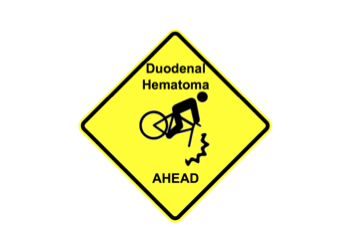Duodenal Hematoma

Duodenal Hematoma: Anatomy Matters
- Anatomic features that make children more susceptible to blunt abdominal trauma:
- Less protective covering.
- Thinner abdominal muscles and less fat.
- Less protective ribs.
- The compliant ribs do not dissipate force.
- That transmitted force now is absorbed by the underlying organs and structures.
- More exposed solid organs.
- The diaphragm is more horizontal compared to older patients.
- The liver and spleen are, thus, more anterior and less protected by rib cage.
- Less protective covering.
- All abdominal organs are at risk for injury. (Maguire, 2013)
- Solid Organs
- Hollow Organs (12% of hospitalizations)
- Duodenal hematoma, perforation, and transection have been documented.
- Often present in delayed fashion:
- Both accidental trauma non-accidental trauma can lead to DELAYED presentations.
- May take more than 24 hours to manifest its severity. [Alkan, 2012; Clendenon, 2004]
Duodenal Hematoma: Basics
- The duodenum is relatively protected given its retroperitoneal location.
- Injuries to the duodenum are uncommon. [Sowrey, 2013]
- <1% of traumas involved the pediatric duodenum. [Clendenon, 2004]
- Unfortunately, historic data shows high mortality rates for those with duodenal injuries, although more recent data has lower mortality rates. [Clendenon, 2004]
- Close proximity to other structures increases chance of concomitant injuries. [Sowrey, 2013]
- Duodenal injuries: Adults vs Children
- Adults injure their duodenum via penetrating trauma most often.
- Children most often experience duodenal injuries via blunt trauma.
- Unfortunately, this blunt force is often encountered through abuse. [Clendenon, 2004]
- Difficult to diagnose:
- Retroperitoneal location makes imaging less reliable.
- Plain xrays will not show free air from duodenal perforations.
- CT scans may show only subtle findings. [Kurkchubasche, 1997]
- May lack external signs of trauma.
- Delayed presentations make appreciation difficult.
- Initial assessment following abdominal injury may under-represent the true injury.
- Requires high index of suspicion.
- Retroperitoneal location makes imaging less reliable.
- Duodenal hematoma can lead to a partial or complete bowel obstruction.
Duodenal Hematoma: Mechanisms
- Common blunt mechanism:
- ABUSE
- Numerous reports of duodenal injuries being related to non-accidental trauma. [Sowrey, 2013; Terreros, 2009; Gaines, 2004]
- For younger children (< 5 years of age) abuse is the MOST COMMON mechanism of duodenal injury.[Sowrey, 2013]
- Abuse should be suspected in all cases of duodenal injury in children < 2 years of age unless due to a witnessed motor vehicle collision. [Sowrey, 2013]
- Bicycle handlebars [Alkan, 2012]
- Handlebars can lead to penetrating or blunt trauma.
- Hockey sticks
- Motor Vehicle Collisions and All-Terrain Vehicle crashes
- Fall onto object or object crushing down onto abdomen
- Sports-related impacts
- Invasive procedures [Sahn, 2015]
- ABUSE
- Crushing mechanism:
- Mechanism is similar to the lap-belt complex injuries, but higher location on the abdomen.
- Duodenum is crushed between the vertebral column and the handlebar.
Moral of the Morsel
- Bikes are fun… but their handlebars can be painful! Don’t overlook the history of blunt trauma to a child’s abdomen, even if the exam is not revealing.
- Be vigilant, but reasonable. Don’t CT ever child with a mild blunt force to the belly. GIVE GOOD ANTICIPATORY GUIDANCE and document that conversation.
- Be suspicious of injuries in the young! If you find a duodenal (or any) injury in a young child, consider non-accidental injury.
References
Sahn B1, Anupindi SA, Dadhania NJ, Kelsen JR, Nance ML, Mamula P. Duodenal hematoma following EGD: comparison with blunt abdominal trauma-induced duodenal hematoma. J Pediatr Gastroenterol Nutr. 2015 Jan;60(1):69-74. PMID: 25207477. [PubMed] [Read by QxMD]
Sowrey L1, Lawson KA, Garcia-Filion P, Notrica D, Tuggle D, Eubanks JW 3rd, Maxson RT, Recicar J, Megison SM, Garcia NM. Duodenal injuries in the very young: child abuse? J Trauma Acute Care Surg. 2013 Jan;74(1):136-41; discussion 141-2. PMID: 23271088. [PubMed] [Read by QxMD]
Maguire SA1, Upadhyaya M, Evans A, Mann MK, Haroon MM, Tempest V, Lumb RC, Kemp AM. A systematic review of abusive visceral injuries in childhood–their range and recognition. Child Abuse Negl. 2013 Jul;37(7):430-45. PMID: 23306146. [PubMed] [Read by QxMD]
Alkan M1, Iskit SH, Soyupak S, Tuncer R, Okur H, Keskin E, Zorludemir U. Severe abdominal trauma involving bicycle handlebars in children. Pediatr Emerg Care. 2012 Apr;28(4):357-60. PMID: 19680164. [PubMed] [Read by QxMD]
Terreros A1, Zimmerman S. Duodenal hematoma from a fall down the stairs. J Trauma Nurs. 2009 Jul-Sep;16(3):166-8. PMID: 19888022. [PubMed] [Read by QxMD]
Gaines BA1, Shultz BS, Morrison K, Ford HR. Duodenal injuries in children: beware of child abuse. J Pediatr Surg. 2004 Apr;39(4):600-2. PMID: 15065036. [PubMed] [Read by QxMD]
Clendenon JN1, Meyers RL, Nance ML, Scaife ER. Management of duodenal injuries in children. J Pediatr Surg. 2004 Jun;39(6):964-8. PMID: 15185235. [PubMed] [Read by QxMD]
Plancq MC1, Villamizar J, Ricard J, Canarelli JP. Management of pancreatic and duodenal injuries in pediatric patients. Pediatr Surg Int. 2000;16(1-2):35-9. PMID: 10663831. [PubMed] [Read by QxMD]
Kurkchubasche AG1, Fendya DG, Tracy TF Jr, Silen ML, Weber TR. Blunt intestinal injury in children. Diagnostic and therapeutic considerations. Arch Surg. 1997 Jun;132(6):652-7; discussion 657-8. PMID: 9197859. [PubMed] [Read by QxMD]
Winthrop AL, Wesson DE, Filler RM. Traumatic duodenal hematoma in the pediatric patient. J Pediatr Surg. 1986 Sep;21(9):757-60. PMID: 3772698. [PubMed] [Read by QxMD]


Can it be treated conservatively.